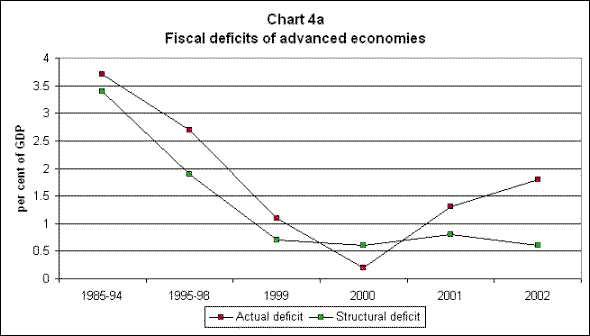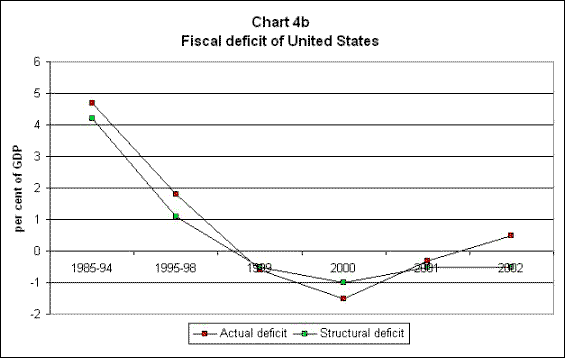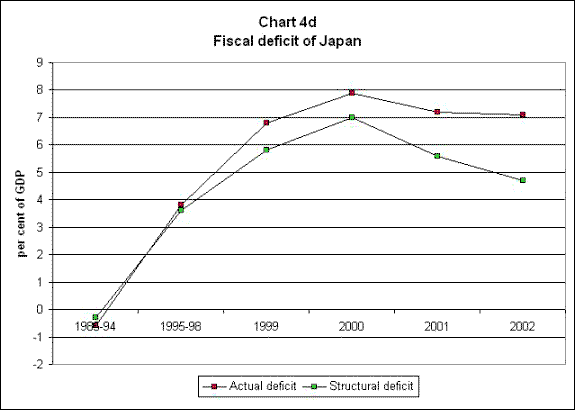|
Consider
the evidence presented in Charts 4a to 4d. The first
point to not is how the fiscal deficits have been declining
quite rapidly as shares of GDP in all the advanced countries
taken as a group, to very low levels. In fact, in terms
of structural deficit (that is, accounting for the fact
that fiscal deficits move with business cycles, increasing
in slumps and declining in booms), the fiscal deficit
in the major advanced economies was less than 2 per
cent of GDP in the latter half of the 1990s and has
been less than 1 per cent thereafter.

Chart
4a >>
Click to Enlarge
In the United States,
the boom was originally led by large increases in government
spending combined with tax cuts. In the mid-1990s, however,
the
US, despite being the country
with the international reserve currency, chose to curtail
its fiscal deficits initially. And when the US government
was confronted with surpluses in the course of the boom
triggered by private spending, it chose to hand over
some part of those surpluses to the private sector in
the form of tax cuts. As Chart 4b shows, since 1999
the US government budget has been in surplus (negative
deficit indicates surplus).

Chart
4b>>
Click to Enlarge
Nevertheless, the US economy continued to surge ahead
in growth terms over this period. The demand increase
was therefore entirely private sector-led, fuelled by
debt-driven household consumption increases which were
inspired by the capital gains made by those with some
direct or indirect investment in stocks and shares.
Since the middle of 2000, however, such capital gains
have turned negative.
However, fiscal policy has responded by becoming more
expansionary only in the very recent past, with expenditure
increases of just under $100 billion being announced
in the wake of the terror and anthrax attacks. Instead,
over most of 2001, official policy has been directed
towards a looser monetary policy, with the US Federal
Reserve announcing six interest rate cuts over the course
of the year. However the interest rate cuts alone have
done very little to push the economy out of the current
recession.
In Europe, the attempts at fiscal compression seem to
have gone much further than even the fairly stringent
requirements of the Stability and Growth Pact. Both
the actual and structural fiscal deficits (shown in
Chart 4c) since 1998 have been amazingly low, well below
1.5 per cent of GDP, despite the evident recession and
the continuing high level of unemployment. Given the
supposed political domination of Social Democratic parties
in most of the government of Euro area countries, this
pattern obviously requires greater political economy
analysis.

Chart
4c>>
Click to Enlarge
But the most striking pattern is that of the Japanese
economy (Chart 4d), in which the fiscal stimulus appears
to have been used with much effort but to little effect
over the past few years. The Japanese government budget
has moved from the modest surpluses which characterised
the decade until 1985, to very large deficits amounting
in some years to nearly 8 per cent of GDP. These were
part of the efforts to pump-prime the system, along
with low nominal interest rates that have reached near-zero
levels. But still they have not been able to lift the
Japanese economy out of the deflationary spiral.

Chart
4d>>
Click to Enlarge
What do these contrasting fiscal patterns and their
even more contrasting results suggest ? It would be
wrong to infer from these that fiscal policy is not
an important means of changing levels of economic activity
in the advanced capitalist economies. However, these
data do suggest that the pattern of fiscal stance, of
the kind of spending and taxation decisions that are
made, may be even more significant than the absolute
levels. Crucially, they are important because they can
change levels of employment, and these in turn play
an important role in affecting expectations of economic
agents in the economy.
Thus, in the US economy,
the fiscal stance could be low because the consumption
boom was associated with employment growth which in
turn added to higher private spending. Conversely, in
Japan the combination of fiscal stimulus and interest
rate cuts was not sufficient to reverse the trend of
declining employment opportunities. These led to depressed
expectations, which in turn meant that additional incomes
tended to be saved to insure against future job loss,
and therefore did not translate into higher economic
activity.
|

